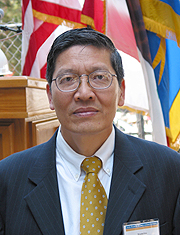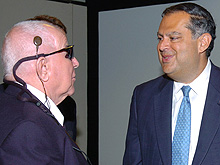|

In the retinal prosthesis, a
chip implanted in the eye receives image data transmitted
over a wireless connection from the high-tech glasses.
Image courtesy USC
|
October 18, 2004
UCSC researchers join in new partnership
to speed development of an 'artificial retina' to restore sight
By Tim Stephens
In an effort to speed the design and development of an artificial
retina that could potentially help millions of people blinded
by retinal diseases, Secretary of Energy Spencer Abraham announced
last week that five Department of Energy (DOE) national laboratories,
a private company, and three universities--including UCSC--have
signed agreements to form a research partnership.

Wentai Liu, professor of
electrical engineering, is leading UCSC's participation in
the project.
Photo: Tim Stephens
|
The goal of the agreements signed in Chicago on October 14,
is to advance the science, technology, and clinical success
of the field of artificial sight using the facilities and resources
of DOE's national laboratories.
Wentai Liu, professor of electrical engineering, leads UCSC's
participation in this project. He traveled to Chicago last week
to take part in the signing ceremony.
Liu, who came to UCSC in 2003, has been working for more than
a decade on the artificial retina in collaboration with researchers
at the University of Southern California (USC) and other institutions.
Liu is also campus director of the Center for Biomimetic MicroElectronic
Systems (BMES), a national Engineering Research Center based
at USC. The artificial retina is one of the test-bed projects
for BMES.
At the announcement in Chicago, the first patient to receive
a prototype implant in 2002 described what it was like being
able to "see" large letters and to differentiate between
a cup, a plate, and a knife after being blind for over 50 years.
To date, six volunteers have received implants of a microelectronic
device that rests on the surface of the retina to perform the
function of normal photoreceptive cells. The artificial retina
technology was featured at DOE's "What's Next Expo,"
an event designed to showcase the newest, most innovative, cutting-edge
scientific and technological advances to interest young people
in pursuing careers in math and science.
"The Department of Energy has led the way to many scientific
breakthroughs, especially when several scientific disciplines
combined to make a whole greater than the sum of the parts,"
Secretary Abraham said. "This project is one such example
where biology, physics, and engineering have joined forces to
deliver a capability that will enable blind people to see. This
agreement between the DOE laboratories and the private sector
will facilitate transfer of many aspects of DOE technology to
a clinical device that has the potential of restoring sight
to millions of blind individuals."

Harold Churchey, one of the first
patients to receive an artificial retina, shakes hands
with Energy Secretary Spencer Abraham. The Department
of Energy is supporting a partnership that includes UCSC
to speed development of the artificial retina.
Photo George Joch, Department of Energy Argonne Lab
|
The agreements allow Second Sight Medical Products Inc. based
in Sylmar, Calif., to obtain a limited exclusive license for
inventions developed during the artificial retina project. Under
the research agreements, the institutions will jointly share
intellectual property rights and royalties from their research.
This will speed progress by freeing the researchers to share
details of their work with their collaborators.
The artificial retina could help those blinded by age-related
macular degeneration or retinitis pigmentosa, diseases in which
neural wiring from the eye to brain is intact, but the eyes
lack photoreceptor activity.
The artificial retina is a device that captures visual signals
and sends them to the brain in the form of electrical impulses.
The device is a miniature disc that contains an electrode array
that can be implanted in the back of the eye to replace a damaged
retina. Visual signals are captured by a small video camera
in the eyeglasses of the blind person and processed through
a microcomputer worn on a belt. The signals are transmitted
to the electrode array in the eye. The array stimulates optical
nerves, which then carry a signal to the brain. The first prototype
implants contain 16 electrodes. The next prototype, with 50
to 100 electrodes, is in preclinical trials. The project's "next-generation"
device would have 1,000 electrodes, and researchers hope it
would allow the user to see images.
The DOE-supported project is a collaboration of national laboratories,
universities, and the private sector. Oak Ridge National Laboratory
and the University of Southern California Doheny Eye Institute
are leading the multilaboratory effort. Liu's work at UCSC includes
wireless communication technology to provide the link between
the camera and the implant.
Other partners in the collaboration are Argonne National Laboratory,
Lawrence Livermore National Laboratory, Los Alamos National
Laboratory, Sandia National Laboratories, North Carolina State
University, and Second Sight.
The project's goal is to construct the device, capable of restoring
vision, with materials that will last for the lifetime of a
blind person. Although images will initially be captured by
a camera housed in an eyeglass frame, researchers hope eventually
to develop a completely implanted system for this purpose.
The Energy Department's Office of Science plans to fund the
artificial retina project at $20 million over the next three
years. The department funds the project as part of its medical
applications technology program. The National Institutes of
Health and the National Science Foundation are also supporting
the project.
Additional information on the artificial retina project is
available at science.doe.gov.
Return to Front Page